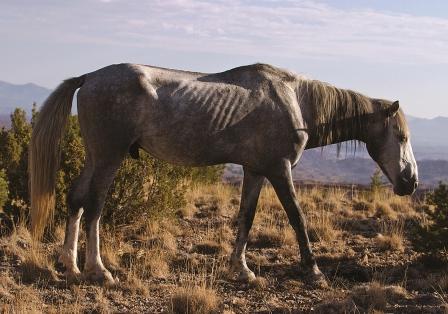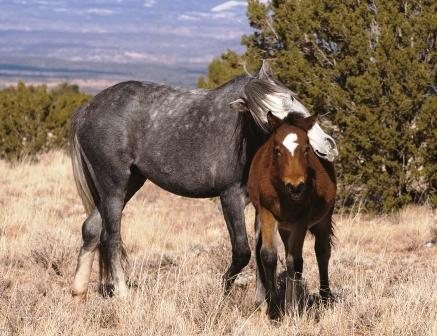State orders wild mammals euthanized
Wildlife rehabilitators were distraught to learn in June that the New Mexico Department of Game & Fish would no longer allow certain animal species to be released into the wild. Aletter from Cal Baca, chief of the Wildlife Management Division, asks that facilities such as Wildlife Rescue Inc. and The Wildlife Center in Española instead euthanize all foxes, raccoons, bobcats, bats, coyotes, and skunks brought to them.
“Several cases of rabies have been confirmed in New Mexico wildlife this year, including raccoons, foxes, bats, and skunks,” the June 12 letter reads.
Baca confirmed that the request is, in effect, an order, since wildlife rehabilitators cannot release animals without state permission, or they risk losing their permits. The order also instructs them to advise the public not to touch any wild animals in distress. “Unless it’s going into a controlled situation like a zoo,” Baca told us; “I would be OK with that. But if they’re releasing into the wild, we would rather they be euthanized and not become a disease vector.”
“To say that we are not happy with the decision is putting it mildly,” said Kerrin Grant, wildlife care director at The Wildlife Center, adding that she was not free to offer her opinion because of the center’s official relationship with state and federal wildlife agencies. She did note that the order excludes animals currently in their care, “so at least we don’t have to euthanize animals we have already invested time and energy into helping.”
Corrales-based rehabilitator Mikal Deese was more blunt. “I can understand the dictates about not moving critters around the state,” she wrote in an email. “Some of that was already in place. However this blanket ban seems like a war against wildlife. Nothing I’ve read from CDC [U.S. Centers for Disease Control] or from wildlife disease authorities has recommended such a draconian measure.”
Deese said there were rumors within the wildlife community that not everyone planned to comply. The order appears to have been sent to all animal control agencies in New Mexico as well as wildlife rehabilitators.
Kerry Mower, wildlife health specialist for Game & Fish, explained the rationale behind the measure, which he admitted is unprecedented. It is not only the spread of rabies from southwestern New Mexico, he said, but also drought conditions statewide that prompted the decision.
“Many of the release areas already have a high population of these animals, particularly raccoons. Most of these animals are territorial, and that leads to fighting among animals and more dispersion. This year we have such terrible conditions and so little food that we decided it would be prudent to slow the rabies down and not translocate.”
In March, a dog bitten by a fox in Magdalena, near Soccoro, had to be euthanized for rabies. The fox was found to have an Arizona Gray Fox variant of the disease, which set off alarms because it was the farthest north that rabies has been seen.
“We’re really worried that this Arizona fox strain of rabies that’s down there could go into the Rio Grande Valley and spread up and down the valley—it’s a big concern,” Mower said. “We’re seeing rabies on the spread, moving around, and it’s fairly common knowledge that to spread rabies fast, you just transport wildlife around—and humans do it.”
He said the order would not be lifted until “the habitat in some of these areas comes back, so we have more forage being produced for wildlife,” and “when we begin to see rabies be static and not turn up new cases.”
Below: Corrales photographer Lynne Pomeranz has been documenting
the plight of free-ranging horses in Placitas, such as this same stallion before and after
supplemental feeding by Placitas Animal Rescue. An email plea by Pomeranz helped
bring in thousands of dollars in donations to feed the horses during the drought.

Placitas horses being fed
Drought has also literally heated up the controversy over a band of free-roaming horses in Placitas. The horses, which many believe originate with feral runaways from neighboring Pueblos, are in danger of starvation for lack of forage. That probably is contributing to their wandering onto roadsides and backyards, leading residents to complain about safety and ecosystem impact.
Horse photographer and advocate Lynne Pomeranz of Corrales made an appeal on Facebook for donations to provide hay through the nonprofit group Placitas Animal Rescue. “You all know that I have never agreed with the feeding of wild horses when there has been forage available to them,” Pomeranz wrote, “however, this is a true crisis...”

As of mid-July, the effort had raised $5,000 in donations, some from out of state, as well as pledges of hay. That’s enough to feed the estimated 100 horses for five weeks, according to Gary Miles of Placitas Animal Rescue. Miles, with his wife Hattie, have been working nonstop to stock 14 feeding stations, plus other locations where they have permission to drop hay.
Miles and Pomeranz both report that the horses, some of which were “skin and bones” in June, are looking a little better now. “Sometimes when we put the hay down, they come running,” said Miles. “That’s an amazing feeling for us.”
The horses have been seen and enjoyed by many in the open spaces surrounding Placitas for the last five to eight years. But they have grown increasingly controversial as they multiply, forage and trample, foul creeks, and wander onto fast-moving Highway 165. Agroup of residents has been calling for government to step in, but all the agencies involved claim it is not their responsibility or they are powerless to act.
Apublic meeting on the problem called in early June by Sandoval County Commissioner Orlando Lucero and State Sen. John Sapien (D-Corrales) brought out the U.S. Forest Service, U.S. Bureau of Land Management, Coronado Soil and Water Conservation District, City of Albuquerque Open Space, New Mexico Livestock Board, the Wild Horse Observers Association, and San Felipe and Santa Ana Pueblos, all of which have gotten entangled in the debate. No decisions were reached.
The nonprofit Wild Horse Observers Association has offered to remove and find homes for some of the horses, and is seeking permission from various state and federal agencies to dart horses with the birth control PZP. They also have a lawsuit pending to prevent any roundup by the BLM.
Meanwhile, Gary and Hattie Miles, who have run Placitas Animal Rescue for 25 years, estimate that they will have to keep feeding the horses through the winter to keep them alive, since summer rains are unlikely to generate enough forage to sustain the herd.
They will need many more dollars and bales to make that happen. Donations of both are needed at Placitas Animal Rescue, P.O. Box 724, Placitas, NM 87043. Contact Miles at 867-0004 or placitasanimal@yahoo.com.
Black bear dines in Corrales
An alert went out throughout the Village on July 22, via phone tree and email, after a resident spotted a black bear digging through trash cans on Via Oreada, at the south end of the Village.
That night, the animal was seen again by residents of nearby Laker Drive around 3 a.m., after he knocked over a chicken coop and ate a chicken.
According to P. “Frosty” Frostensen, quick work by fellow Animal Services officer Catherine Garcia brought the Corrales Fire Department, PNM, and New Mexico Game & Fish to the scene July 23 when the bear was spotted in a tree at the property around 7:30 a.m. Using the utility’s bucket truck, state game officials shot a tranquilizing dart that sent the bear lower, where he was finally caught in an inflatable bag.
State game officials will decide the bear’s fate. “Because he killed livestock and was remaining in a small area, they may have to euthanize,” said Frosty, “because he may come back.”
He said another bear ended up in Corrales a few years ago, and hibernated in the Village before returning unharmed to the Manzano mountains.
This summer’s bear was judged to be about 5 years old, 125 to 150 pounds, and apparently had feasted on sunflower seeds the previous night.
“He defecated on my truck, so I guess he’s telling me what he thinks,” Frosty said after cleaning sunflower shells out of the bed.
As far as anyone knows, Corrales now has the most restrictive ban in the state on chaining dogs, thanks to an ordinance approved by the Village Council in June. The law, initially proposed as a ban on tying any dog at any time for any reason, was amended to allow for temporary tethering while the dog owner completes a task.
Corrales has also, for now, resolved its months-long dispute over coyotes. After a series of acrimonious public meetings called by Councilor John Alsobrook, a group of five residents agreed to write a survey for residents about the issue. The timing of the survey, and whether any proposals will be made to the Village Council, remain uncertain.
One effect of the controversy has been to motivate coyote defenders to work proactively with Corrales Animal Services to identify and haze coyotes away from areas of conflict with humans. Amother coyote and pup were successfully hazed from their den near the fire substation on Paseo Tomas Montoya where pups have been seized in past years. Two other dens, near an arroyo and in an irrigation culvert, were hazed and appear to have been abandoned.
Bowled & Beautiful, an unusual fundraiser for New Mexico Dogs Deserve Better and Second Chance Animal Rescue, will take place Oct. 5 from 7 to 10 p.m. at the San Gabriel Episcopal Church in Corrales.
Artists volunteered to transform 30 old bowling pins into one-of-a-kind pieces, to be auctioned off at the event. Expect music, food, and animal-lovers, and come pick up a spare for the critters.
If you see an assistance dog this month, blow a kiss (but don’t touch! They are working) for International Assistance Dog Week, Aug. 4-10. Created to raise awareness about the dogs' hard work helping humans with all kinds of disabilities, IADW has a website (assistancedogweek.com), Facebook page, and Twitter feed.
The ingenious honor is the brainchild of Santa Fe author Marcie Davis, a paraplegic who wrote Working Like Dogs: The Service Dog Guidebook.
A sanctuary we’ve just learned about in Santa Fe called Kindred Spirits is having a benefit art show on Saturday, Aug. 10, from 10 a.m. to 4 p.m. The sanctuary is dedicated to helping older dogs, horses, and poultry, including hospice care, at its 4-acre property on Highway 14, a few miles north of Cerrillos.
The benefit show will include painting, photography, jewelry, sculpture, carvings, folk art, and wearable art, all donated by animal-loving artists to support wellness care for the animals. The residents roam freely on the property, so stop in to take a tour through the barns. Visit www.kindredspiritsnnm.com.
